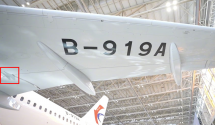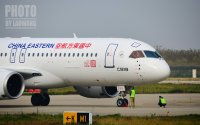You are using an out of date browser. It may not display this or other websites correctly.
You should upgrade or use an alternative browser.
You should upgrade or use an alternative browser.
COMAC C919
- Thread starter Deino
- Start date
slowdown guys. Being able to produce 150 a year is good. That's a nice capability to have for not just airlines but also growth of domestic industries, but that's not a concern right now. Worry about getting C919 to a state where airlines are happy with it. I feel like this early stage of C919 is almost like getting DUVi validated on domestic fabs. A lot of hard work ahead to proof that they are competitive and usable commercially.
slowdown guys. Being able to produce 150 a year is good. That's a nice capability to have for not just airlines but also growth of domestic industries, but that's not a concern right now. Worry about getting C919 to a state where airlines are happy with it. I feel like this early stage of C919 is almost like getting DUVi validated on domestic fabs. A lot of hard work ahead to proof that they are competitive and usable commercially.
Boeing has an estimate that China will need 300 single-aisle airplanes per year for the next 20 years
That would imply 50% market share for COMAC.
Then 25% for Boeing and 25% for Airbus
Or maybe the Boeing share drops to 10% with Airbus at 40%?
I think more like 0% Boeing. And if COMAC does this right, we have 50/50 Airbus and COMAC eventually. Can't see them ordering anymore MAX while the current geopolitical tension is at play. Airbus is licking its chops right now with A220 and A320NEO.Boeing has an estimate that China will need 300 single-aisle airplanes per year for the next 20 years
That would imply 50% market share for COMAC.
Then 25% for Boeing and 25% for Airbus
Or maybe the Boeing share drops to 10% with Airbus at 40%?
Of course even among COMAC orders, the question is how many of them will eventually be mostly using domestic system? Only when you get a de-Americanized aircraft will you be able to sell them to domestic ministries and countries who are afraid of sanctions.
Fuel capacity of the C919 is 24,917 L while A320neo is 29,659 L.
The A320neo carries 19% more fuel. And it has 17% more range. Big whoop.
Just to clarify - this fuel capacity in the A320neo requires the use of 2 cargo hold ACTs (auxiliary fuel tanks), the base aircraft actually carries about 1000l *less* fuel than the C919. Yet, even without the ACTs, it has longer range, likely due to lower empty weight.
See:
COMAC C919
The first C919 airplane is scheduled to be delivered to China Eastern Airlines in December. China Eastern Airlines is set to receive its first (and the world's first commercial) C919 at Shanghai Hongqiao International Airport this Friday, 9 December 2022.
www.sinodefenceforum.com
Still, I'd agree it's not a huge problem.
It is still baffling how it is worse when the A320 is basically a 1980s airframe though.
Generally speaking airframe technology has not advanced as much as engine technology since the late 1980s, especially if you forgo things like composite wings and fuselage like the C919 does. Some lot of the remaining gains can be retrofitted (e.g. newer winglets & re-sculpting the wing body fairing to compensate the effect of the bigger engines on wing pressure distribution, both of which Airbus did). So if the engines are the same two aircraft will perform quite similarly in terms of fuel burn, because that's where the vast majority of the efficiency improvement comes from.
More specifically, the C919 wing seems to owe a lot to the A320neo anyway. It has different wing tip devices and a smooth transition in TE sweep rather than a kink, but otherwise is very similar down to minor details like these:

The other, more interesting questions are (as others have mentioned) reliability and maintenance cost in service.
Probably the case. Another reason is that Boeing does not have a final assembly line in China, but Airbus does. And Airbus is considering expanding the scale and bringing more models (A321NX, the game changer) to Tianjin.I think more like 0% Boeing. And if COMAC does this right, we have 50/50 Airbus and COMAC eventually. Can't see them ordering anymore MAX while the current geopolitical tension is at play. Airbus is licking its chops right now with A220 and A320NEO.
Of course even among COMAC orders, the question is how many of them will eventually be mostly using domestic system? Only when you get a de-Americanized aircraft will you be able to sell them to domestic ministries and countries who are afraid of sanctions.








